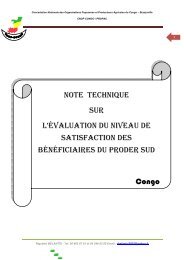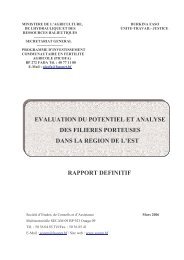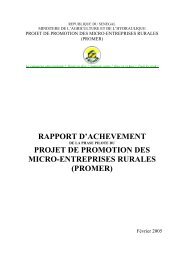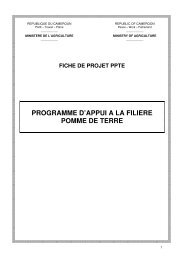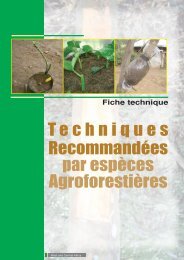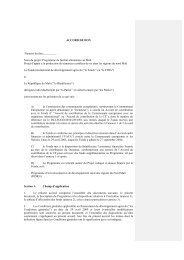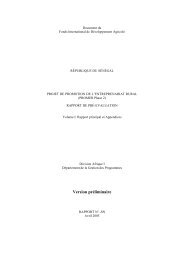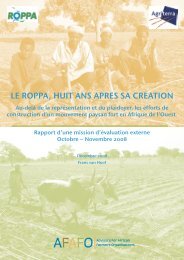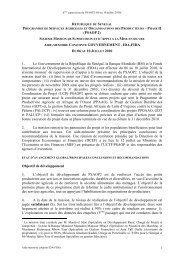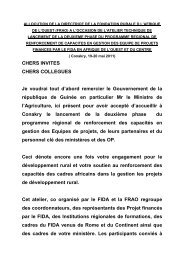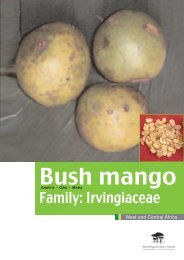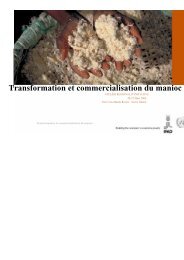Scaling Up the Fight Against Rural Poverty - FIDAfrique
Scaling Up the Fight Against Rural Poverty - FIDAfrique
Scaling Up the Fight Against Rural Poverty - FIDAfrique
You also want an ePaper? Increase the reach of your titles
YUMPU automatically turns print PDFs into web optimized ePapers that Google loves.
of local government and communal institutions and organizations accompanied by an open<br />
investment menu leveraging people’s own resources.<br />
• As regards institutions, IFAD’s project initiatives were replicated and scaled up by at least two<br />
o<strong>the</strong>r donors: by <strong>the</strong> World Bank in <strong>the</strong> ALIADOS project which built on IFAD’s successful<br />
strategy in <strong>the</strong> Sou<strong>the</strong>rn highlands; and by <strong>the</strong> KfW of Germany in <strong>the</strong> Agro-Environmental<br />
Program, which applied <strong>the</strong> competitive awards mechanisms and o<strong>the</strong>r instruments used in<br />
IFAD projects. Recently <strong>the</strong> government broadened <strong>the</strong> institutional framework for rural<br />
poverty reduction by creating <strong>the</strong> AGRO RURAL umbrella organization under <strong>the</strong> Ministry of<br />
Agriculture for all rural interventions under which all governmental and donor-funded<br />
programs are now systematically developed and implemented.<br />
c) <strong>Scaling</strong>-up pathways – <strong>the</strong> drivers:<br />
Among external forces that helped shape <strong>the</strong> development of <strong>the</strong> Peruvian approach to rural<br />
development <strong>the</strong>re were <strong>the</strong> economic crisis and structural reforms in <strong>the</strong> 1990s. They had undermined<br />
<strong>the</strong> capacity of <strong>the</strong> state to pursue top-down, centrally led rural development programs. In addition<br />
<strong>the</strong>re was <strong>the</strong> impact of <strong>the</strong> battle against <strong>the</strong> Shining Path movement and its aftermath. All <strong>the</strong>se<br />
factors encouraged a community-based rural development strategy that involved a unique approach of<br />
bottom-up championship and leadership, rooted in a broad-gauged trust of “campesino” (farmer)<br />
community-led development. A network of local experts and NGOs pushed this process forward,<br />
supported by successive governments and assisted by IFAD. IFAD’s long-term Country Program<br />
Manager, who exceptionally was based in Peru for over a decade, apparently played a key role in<br />
pushing <strong>the</strong> process forward.<br />
Ano<strong>the</strong>r critical driver of <strong>the</strong> long-term process of scaling up was a well-aligned and comprehensive<br />
system of incentives and accountabilities, focused on <strong>the</strong> articulation and transmission of community<br />
demand as a key factor pushing <strong>the</strong> scaling up process forward. This included a number of important<br />
instruments that empowered and incentivized <strong>the</strong> highland communities:<br />
• <strong>the</strong> transfer of funds directly to communities through a democratic process involving “local<br />
resource allocation committees”;<br />
• <strong>the</strong> empowerment of communities to allocate <strong>the</strong>se funds according to <strong>the</strong>ir own priorities and<br />
to local contractors of <strong>the</strong>ir choice; and<br />
• <strong>the</strong> incentives provided to communities through <strong>the</strong> mechanism of competitions among <strong>the</strong>m,<br />
which served as an effective means of encouraging, sharing and replicating local technological<br />
and organizational innovations throughout <strong>the</strong> project area.<br />
d) <strong>Scaling</strong> up – creating <strong>the</strong> space to grow:<br />
The Peru case study identified a number of key spaces that were created by <strong>the</strong> government, <strong>the</strong><br />
communities and IFAD that made it possible for <strong>the</strong> scaling up process to proceed:<br />
• Political space: No significant political obstacles got in <strong>the</strong> way of expanding systematically<br />
and consistently <strong>the</strong> bottom up, community driven rural development process. This was in part<br />
because of <strong>the</strong> external drivers mentioned above, and in part a result of <strong>the</strong> broad-gauged<br />
networking efforts involving many stakeholders in and out of government, in academia and<br />
think tanks, NGOs and with international partners.<br />
• Policy and institutional space: Over time <strong>the</strong> necessary policy and institutional space was<br />
created by establishing <strong>the</strong> legal foundations for <strong>the</strong> decentralized and community driven<br />
approach, including <strong>the</strong> development of institutional focal points at <strong>the</strong> local level for <strong>the</strong><br />
disbursement of funds, <strong>the</strong> integration of <strong>the</strong> project implementation units (PIUs) into <strong>the</strong><br />
ministerial structures, continuity in <strong>the</strong> staffing and leadership of PIUs, and <strong>the</strong> recent creation<br />
17



